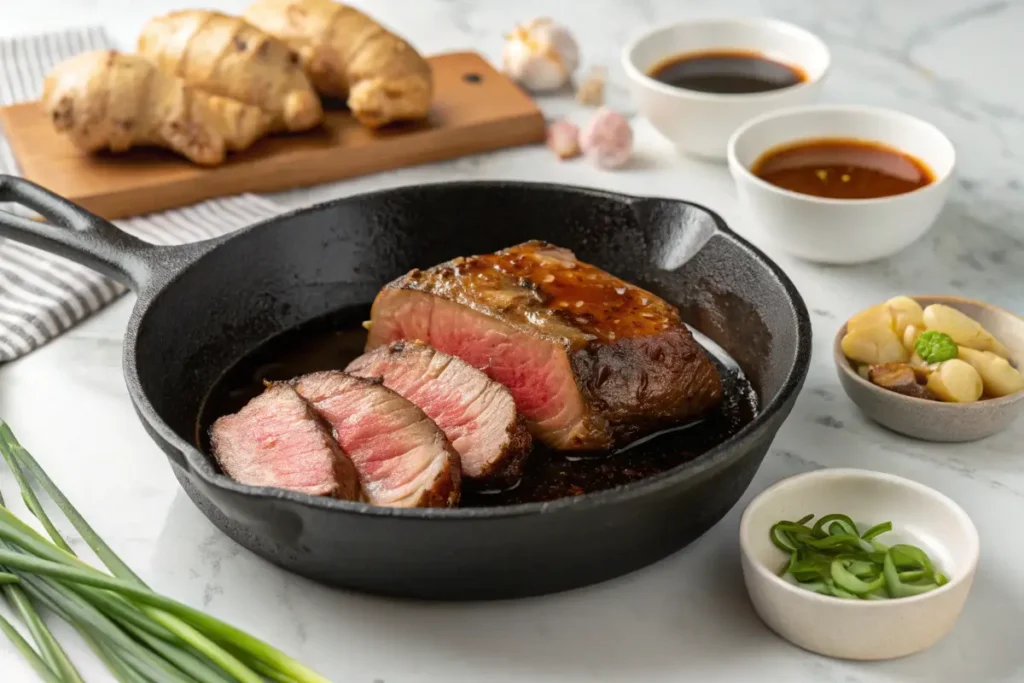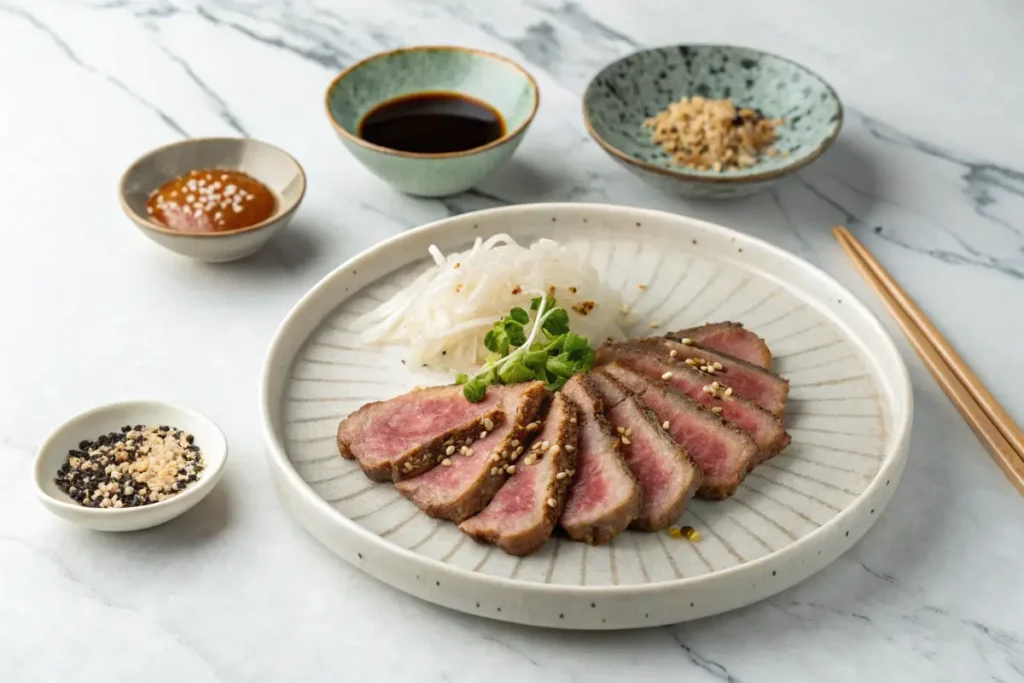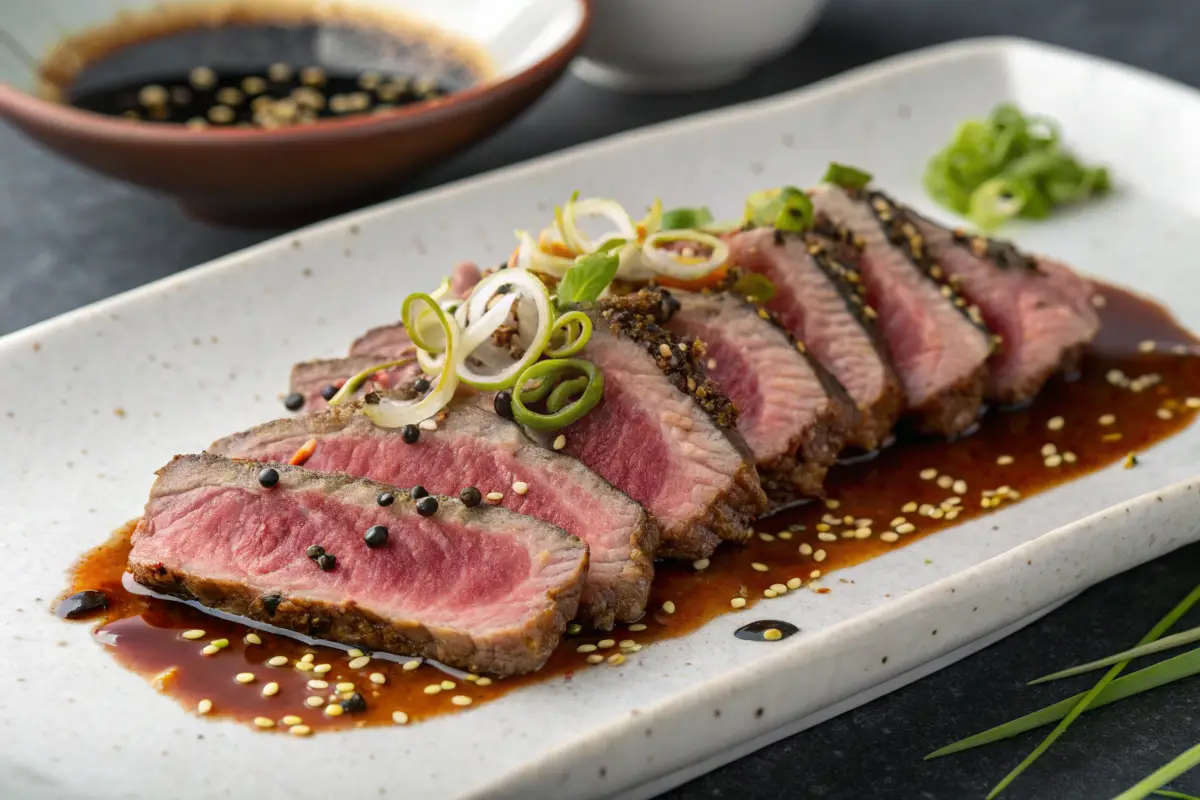Have you ever heard of beef tataki and wondered, “What exactly is it?” Well, you’re in for a treat! This Japanese dish is like a perfect blend of steak and sashimi, offering a rich yet delicate taste that will make your taste buds dance. It’s a dish loved by foodies for its simple preparation and bold flavors. Let’s dive into everything you need to know about beef tataki!
Table of Contents
Introduction to Beef Tataki
The Origins of Beef Tataki
Beef tataki has its roots in Japanese cuisine, known for its minimalistic approach to cooking. The word “tataki” translates to “pounded” or “hit” in Japanese, though in the culinary world, it refers to a lightly seared preparation. Originally inspired by methods used for fish, this technique was adapted for beef, making it a popular choice among meat lovers. Think of it as Japan’s answer to the perfect medium-rare steak but with a lot more finesse.
Cultural Significance in Japanese Cuisine
In Japan, beef tataki represents more than just a dish. It’s a celebration of high-quality ingredients prepared with care. Served as an appetizer or a side dish, it’s often enjoyed during special occasions or at traditional izakayas (Japanese pubs). It’s all about savoring the natural flavors of beef, enhanced by simple yet flavorful accompaniments like soy sauce and citrusy ponzu.
“Beef tataki is a reminder that sometimes, less really is more. Simple techniques, fresh ingredients, and a lot of heart go into making this dish unforgettable.”
What Makes Beef Tataki Unique?
The Art of Lightly Seared Beef
What sets beef tataki apart from other beef dishes? It’s all about the sear. The beef is quickly seared on the outside while leaving the inside rare and tender. This creates a contrast of textures and flavors—crispy, caramelized edges meet juicy, melt-in-your-mouth meat. It’s like the best of both worlds in every bite.
Key Ingredients Used in Beef Tataki
The magic of beef tataki lies in its simplicity. Here’s a quick breakdown of the core ingredients:
| Ingredient | Quantity |
|---|---|
| Beef (sirloin or tenderloin) | 300g |
| Soy sauce | 3 tablespoons |
| Rice vinegar | 2 tablespoons |
| Garlic | 2 cloves, minced |
| Ginger | 1 tablespoon, grated |
| Green onions | 2 stalks, finely chopped |
| Ponzu sauce (optional) | 2 tablespoons |
These ingredients work together to elevate the natural flavors of the beef. Simple, yet so effective.
How is Beef Tataki Prepared?
Selecting the Best Cut of Beef
If you want your beef tataki to turn out amazing, start with the right cut. Tenderloin or sirloin are excellent choices because they’re tender and have just the right amount of fat. Look for high-quality beef, preferably marbled, as it will yield the juiciest results. Wagyu beef is often used in Japan, but any high-grade beef will do the trick.

The Seared Technique Explained
Now, here’s where the magic happens. The beef is seared over high heat for just 20–30 seconds on each side. This locks in the juices and gives the outer layer a beautiful brown crust while keeping the center rare. It’s like giving the meat a quick suntan!
“When searing, don’t forget to use a cast-iron skillet or a pan that holds heat well. You want that instant sizzle as the beef hits the surface!”
Creating the Perfect Marinade
The marinade is where the flavors deepen. A mixture of soy sauce, rice vinegar, ginger, and garlic forms the base. For a citrusy kick, you can add ponzu sauce or freshly squeezed lime juice. After searing, the beef is sliced thinly and briefly marinated to soak up these vibrant flavors.
Serving Suggestions and Presentation Tips
Beef tataki is as much about the presentation as the flavor. Arrange the thin slices neatly on a plate, drizzle with marinade, and garnish with green onions, sesame seeds, or microgreens. You can serve it with a side of shredded daikon radish for a refreshing crunch.
“Presentation is everything! A beautiful plate of beef tataki can turn any meal into a fine dining experience right at home.”

What Does Beef Tataki Taste Like?
Flavor Profile of Beef Tataki
So, what does it taste like? Imagine the umami richness of rare beef, the zesty tang of citrus, and the savory depth of soy sauce. The flavors are clean and balanced, making it a light yet satisfying dish. It’s like a symphony of tastes that play perfectly together.
Complementary Sauces and Garnishes
Simple yet impactful garnishes enhance the flavor of beef tataki. Try it with a drizzle of sesame oil or a dollop of wasabi for a little heat. Pickled ginger or grated daikon radish adds a refreshing element. Each bite becomes an adventure!
Common Problems and Solutions in Making Beef Tataki
Like any culinary masterpiece, making beef tataki comes with its challenges. But don’t worry—we’ve got solutions for you! Let’s look at some common issues and how to fix them so you can achieve restaurant-quality results at home.
Overcooking the Beef: How to Avoid It
One of the most frequent mistakes is overcooking the beef. Remember, the charm of beef tataki lies in its rare center. If you’re not careful, you might end up with a fully cooked steak, which, while delicious, is not tataki. The key is to sear the beef over high heat for no more than 30 seconds per side.
“Pro tip: Make sure your pan is smoking hot before you add the beef. This ensures a quick sear without cooking the inside.”
Achieving the Right Marinade Balance
A poorly balanced marinade can ruin the dish. Too salty, and it overpowers the beef. Too sour, and it feels one-dimensional. Aim for harmony between salty (soy sauce), tangy (rice vinegar or ponzu), and aromatic (garlic and ginger). Taste your marinade before adding the beef to ensure it’s just right.
Maintaining Food Safety for Raw and Rare Dishes
Since beef tataki involves a rare center, food safety is critical. Use fresh, high-quality beef, and make sure to sear the surface to eliminate any bacteria. Always use clean utensils and cutting boards to avoid cross-contamination. When in doubt, freeze the beef for 24 hours beforehand to kill any potential parasites.
Health Benefits and Nutritional Value of Beef Tataki
Beef tataki isn’t just delicious—it’s also packed with nutrients. Let’s break down its health benefits and how it fits into a balanced diet.
| Nutrient | Per Serving (100g) |
|---|---|
| Calories | 200 |
| Protein | 22g |
| Fat | 12g |
| Iron | 2.7mg (15% DV) |
| Vitamin B12 | 2.4μg (100% DV) |
Protein and Essential Nutrients in Beef Tataki
Beef is an excellent source of high-quality protein, essential for muscle repair and growth. It’s also rich in iron, which helps transport oxygen throughout the body, and vitamin B12, crucial for brain health. A serving of beef tataki is a nutrient-packed option for those looking to boost their energy levels.
Calorie Count and Portion Control
Despite its indulgent taste, beef tataki is relatively low in calories compared to other beef dishes. However, moderation is key. Pair it with light sides like salad or steamed vegetables to keep the meal balanced.
Popular Variations of Beef Tataki
While the traditional version of beef tataki is a classic, there are many creative spins on the dish that you can try. These variations are perfect if you’re looking to experiment or add a personal touch.
Modern Twists on Traditional Beef Tataki
Chefs around the world have added their flair to beef tataki. Some popular twists include:
- Truffle Beef Tataki: Infused with truffle oil for a luxurious touch.
- Spicy Beef Tataki: Served with chili oil or a spicy ponzu sauce for those who love heat.
- Smoked Beef Tataki: Slightly smoked for a deeper, more complex flavor profile.
These adaptations bring out new dimensions of flavor while staying true to the essence of tataki.
Regional Adaptations and Pairings
In Japan, the way beef tataki is served can vary by region. For example:
- Kansai Style: Often served with a tangier ponzu sauce.
- Kanto Style: Features a sweeter soy-based marinade.
Pairing beef tataki with other Japanese dishes like sushi, miso soup, or edamame creates a well-rounded meal. For a more international spin, serve it alongside roasted vegetables or a crusty baguette.
Tips for Ordering Beef Tataki at Restaurants
If you’re new to beef tataki, ordering it at a restaurant can be a bit intimidating. Here’s how to make sure you get the best experience:
What to Look for in a Good Beef Tataki Dish
A high-quality beef tataki should have thin, evenly sliced pieces of beef with a perfectly seared crust. The marinade should enhance the meat’s flavor without overpowering it. Pay attention to the presentation, too—it’s a sign of the chef’s care and expertise.
Questions to Ask Your Server
Don’t be shy about asking questions. Here are some to consider:
- What cut of beef is used?
- Is the marinade house-made?
- What sauces or sides are recommended?
“Asking the right questions not only helps you make an informed choice but also shows the chef you appreciate their craft.”
Pairing Beef Tataki with Other Dishes
Beef tataki is a versatile dish that pairs beautifully with a variety of sides and beverages. Whether you’re hosting a dinner party or enjoying a quiet meal at home, the right pairings can elevate the experience to a whole new level.
Best Sides to Serve with Beef Tataki
To complement the light, flavorful nature of beef tataki, consider serving it with these sides:
- Shredded Daikon Radish: Its crisp, refreshing crunch adds a delightful contrast to the tender beef.
- Seaweed Salad: With its umami flavor and slightly chewy texture, seaweed salad is a classic accompaniment.
- Steamed Edamame: These salty, protein-packed soybeans make for a perfect light side dish.
- Pickled Vegetables: Add some tang with pickled cucumbers, carrots, or ginger.
Pairing these sides with beef tataki not only balances the meal but also enhances its presentation, creating a feast for both the eyes and the palate.
Where to Find the Best Beef Tataki
Now that you’re eager to try beef tataki, where can you find it? While you can always make it at home (more on that later), tasting it at a restaurant first can give you an idea of what to aim for.
Top Restaurants Serving Authentic Beef Tataki
Many Japanese restaurants offer beef tataki, but not all are created equal. Look for places known for their attention to detail and quality ingredients. Sushi bars or high-end izakayas often serve some of the best versions.
Pro tip: Check online reviews or ask locals for recommendations to find hidden gems. If you’re lucky enough to be in Japan, cities like Kyoto and Osaka are famous for their traditional tataki preparations.
Tips for Making It at Home Like a Pro
If you prefer a DIY approach, making beef tataki at home is doable. Here’s a quick checklist to ensure success:
- Use fresh, high-quality beef. Ask your butcher for their best cut.
- Invest in a cast-iron skillet or a heavy-duty pan for the perfect sear.
- Don’t skip the marinade—it’s the secret to flavor!
- Slice the beef thinly against the grain for maximum tenderness.
- Take your time with the presentation—remember, we eat with our eyes first!
“Making beef tataki at home might feel intimidating at first, but with a little practice, you’ll be impressing your family and friends in no time.”
Conclusion
Why Beef Tataki Should Be Your Next Culinary Adventure
If you’ve been searching for a dish that’s equal parts elegant and approachable, beef tataki is it. Its unique combination of textures and flavors makes it a standout choice for food lovers everywhere. Plus, it’s a dish that showcases the beauty of simplicity in cooking.
Recap of Key Tips and Insights
Here’s a quick recap of what we’ve covered:
- Origins and uniqueness: Beef tataki is a Japanese dish that’s lightly seared on the outside and rare on the inside.
- Preparation tips: Use high-quality beef, master the quick sear, and balance your marinade.
- Health benefits: Packed with protein, iron, and B12, it’s as nutritious as it is delicious.
- Variations and pairings: Experiment with modern twists and pair with complementary sides and drinks.
- Where to find it: Seek out top Japanese restaurants or try making it at home for a fun culinary challenge.
Now that you’re armed with all this knowledge, it’s time to take the plunge. Whether you’re enjoying beef tataki at a restaurant or trying your hand at making it, one thing’s for sure—it’s an experience you won’t forget.
“Beef tataki isn’t just food; it’s a celebration of flavors, textures, and the artistry of Japanese cuisine. Don’t just take my word for it—try it yourself!”
Frequently Asked Questions (FAQs) About Beef Tataki
If you still have some burning questions about beef tataki, don’t worry—you’re not alone! Here’s a helpful FAQ section that addresses common queries, including some from the “People Also Ask” section on Google.
Is tataki raw or cooked?
Tataki is a bit of both! The outer layer of the beef is quickly seared, giving it a slightly cooked texture, while the inside remains raw and tender. This contrast is what makes tataki so special, offering the best of both worlds in every bite.
Is beef tataki meant to be cold?
Yes, beef tataki is typically served at room temperature or slightly chilled. After searing, the beef is often cooled quickly (sometimes even in ice water) to stop the cooking process and retain its freshness. This preparation makes it a refreshing dish, especially in warm weather.
Can you eat beef tataki raw?
Absolutely, but with caution. While the inside of the beef in tataki is raw, it’s crucial to use high-quality, fresh beef that is safe for raw consumption. The outer sear also helps to kill bacteria on the surface, adding an extra layer of safety.
What does tataki mean?
In Japanese, “tataki” translates to “pounded” or “hit,” but in culinary terms, it refers to a method of lightly searing the surface of meat or fish while keeping the inside raw. This technique enhances flavor and texture, making it a hallmark of Japanese cuisine.
How is beef tataki different from carpaccio?
Beef tataki is seared on the outside while remaining raw inside, whereas carpaccio is entirely raw and thinly sliced. Additionally, tataki is typically marinated in a soy-based sauce, while carpaccio is often dressed with olive oil, lemon juice, and Parmesan.
Can you use other meats for tataki?
Yes! While beef is popular, tataki can also be made with fish (like tuna or bonito) and even chicken. The preparation methods may vary slightly, but the principle of lightly searing remains the same.
How long should I sear the beef for tataki?
To achieve the perfect tataki, sear the beef for about 20–30 seconds on each side over high heat. The goal is to create a caramelized crust while keeping the inside rare.
